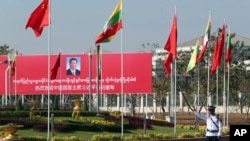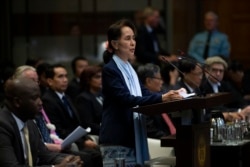With billboards, banners, fanfare and flags, the government of Myanmar is welcoming Xi Jinping, president of the People’s Republic of China, for a two-day state visit beginning Friday that is expected to mark the 70th anniversary of China-Myanmar relations with agreements for infrastructure projects key to Beijing’s ambitious Belt and Road Initiative.
As with any long-term connection, there have been ups, downs and detours.
This will mark Xi's first visit to Myanmar since 2009 before Xi became president and party chief,” Murray Hiebert, senior associate, South Asia Program, Center for Strategic and International Studies (CSIS) in Washington, D.C., told VOA. “After that visit, Myanmar launched reforms, including freeing political prisoners, creating more independence for the media, opening up the economy, deepening relations with the U.S., and cancelling work on the Myitsone Dam which was a big priority for china. Since 2017, Myanmar has again had a falling out with the U.S. because of the expulsion of nearly a million Rohingya Muslim refugees. This [visit] provides an opening for China to build deeper ties with Myanmar again.”
Yun Sun, co-director of the East Asia Program and director of the China Program at the Stimson Center, told VOA, that Xi’s visit is “uniquely high-level,” pointing to last week’s official media briefing conducted by Chinese vice foreign minister Luo Zhaohui.
With the visit Xi “is consolidating his kingdom,” Priscilla Clapp, the chief of mission and permanent charge d’ affaires at the U.S. Embassy in Burma from 1999-2002 told VOA. “Myanmar represents to China the far western province. … I think it is China’s ambition to control Myanmar through economic and other means.”
Clapp continued, “I think China is making a determined effort to harness all of Southeast Asia to the Chinese sphere of influence so it’s not just Myanmar. … Myanmar’s a gateway not only to the Indian Ocean but other parts of southeast Asia.”
The close post-World War II association of the two nations, which share a long border, began when Myanmar, then known as Burma, was the first non-Communist country to recognize the People's Republic of China in 1949. The two nations established diplomatic relations a year later.
China defends Myanmar
Today, as a permanent member of the U.N. Security Council, China has defended Myanmar since it began a military campaign against the Rohingya in 2011. A United Nations fact-finding mission described the campaign as “the gravest crimes under international law,” and called for Myanmar’s senior military officials to face investigation and prosecution for genocide, crimes against humanity, and war crimes. This week, Amnesty International’s Regional Director, Nicholas Bequelin, said “China must stop using its position in the U.N. Security Council to shield Myanmar’s senior generals from accountability. This has only emboldened the military’s relentless campaign of human rights violations and war crimes against ethnic minorities across the country.”
Despite international outcry about treatment of the Rohingya, China stepped up its investments in Myanmar, filling a void left by those departing in part because of the human rights issues. China is the second biggest investor in Myanmar, after Singapore, according to the World Bank. Myanmar's exports to China, its largest trading partner, were worth $5.5 billion in 2018, while imports were worth $6.2 billion.
"We have seen that China has achieved a great success in exploring and following a path suitable for its economic development since the reform and opening up,” Pe Myint, the Union Minister for Information told Reuters. “For Myanmar, we are happy for China, as it's like our relative and friend that has achieved success. It's worth our learning."
And it is those investments that will be in the spotlight during Xi’s visit. Last Friday China’s Luo told reporters in Beijing the purpose of the visit was to strengthen relations and cooperation on China’s Belt and Road Initiative (BRI) and “materialize” the China-Myanmar Economic Corridor (CMEC), a series of projects connecting China with the Indian Ocean. Launched in 2013 by then Chinese president Xi Jinping, BRI includes hundreds of infrastructure projects financed and constructed in part or in whole by Chinese entities that are envisioned as connecting almost all of Asia and Africa.
Belt and Road
In Myanmar, the CMEC is a Belt and Road component.
“If you look at the design of the CMEC, … you can see that it’s designed by China to harness all of the basic infrastructure of Myanmar to Chinese infrastructure, and effectively create another western province beyond Yunnan,” said Clapp.
It is also an area notable for long-running conflicts between the Myanmar military and ethnic armed groups, which are widely believed to receive their weaponry from Chinese sources even as Beijing plays a role in negotiating peace. China is “playing a big role in the peace process but they’re playing both sides of it,” said Clapp. “I think that China’s interest in the long term is keeping some instability on the border so you have a firewall, as it were, between developing democracy in Myanmar, and the lack of democracy in China.”
Xi’s visit comes after Myanmar pulled away from China in 2011 over public opposition to the Myitsone Dam, a $3.6 billion hydropower project. It remains a heated topic, with more than 50 civil society organizations calling on Xi to scratch the project in Kachin State in an open letter issued on Wednesday. Nau Kai Tu Kaung, a Kachin environmentalist told VOA’s Burmese Service that Chinese companies are also involved in destructive environmental endeavors such as rare earth mining.“
[The dam] is highly unpopular,” said Clapp. “It would erupt as a political issue in Myanmar” if the project were revived. She pointed out that the dam’s original design sent more than 90% of the generated electricity to China. “But there were no plans for a transmission line, even into China,” she added. “So it didn’t make sense.”
To succeed today “you have to completely redesign it, and … it has to feed in to the grid in Myanmar, it has to serve the electrical needs of Myanmar, not China. Yunnan doesn’t need the electricity now.”
Xi is scheduled to meet Myanmar’s de factor leader Aung San Suu Kyi and army chief Min Aung Hlaing in the capital Naypyitaw, as well with the heads of an array of political parties. Chinese Ambassador to Myanmar Chen Hai said dozens of agreements will be signed during Xi’s visit.
Clapp said that while the countries may sign memoranda of understanding “those are not final agreements. Even the CMEC, the China Myanmar Economic Corridor is an MOU so it’s aspirational.”
The talks are also expected to touch on a project that involves a deep-sea port in Rakhine state that would give China access to the Indian Ocean. The port project was scaled back in 2018 over fears of a debt-trap, a move critics believe China uses “to gain influence by bankrupting its partners and bending them to its will.”
Clapp said none of the massive infrastructure projects is going to happen quickly. The projects cannot become final until environmental, social and economic assessments are completed, and a business plan completed for each project. Financing for the projects is unclear because “the Myanmar government is not going to take any sovereign debt” and any financing by “big Chinese companies and their partners” will take a long time to put together, especially for large projects.
“I think the most that we’re going to see in the near term is small projects; for example, there are several economic zones along the border that are already under development. The problem with those is that they’re largely unregulated, and they’re going to erupt at some point because they’re bringing in a lot of Chinese migration into Myanmar, [which is] going to cause a big problem with the Myanmar population. In the Karen State, in places where these economic zones are already underway, it’s going to start causing social problems. And this is something that China, Beijing needs to think about over the long terms because it could really destroy the relationship between the two countries if they’re not careful.”
Liyuan Lu is with VOA’s Mandarin Service and Kyaw Zan Tha is with VOA’s Burmese Service.







